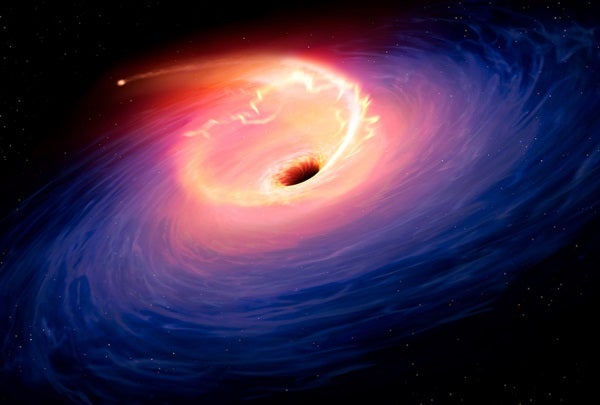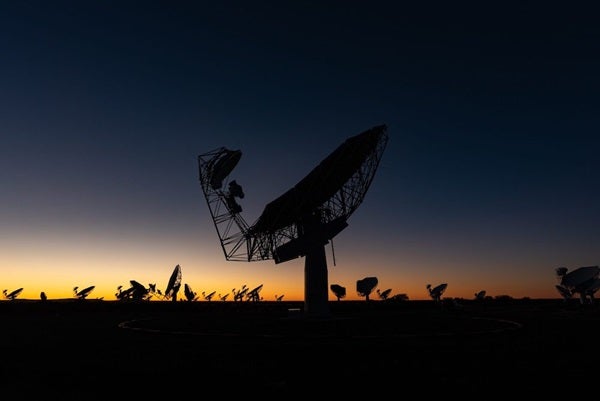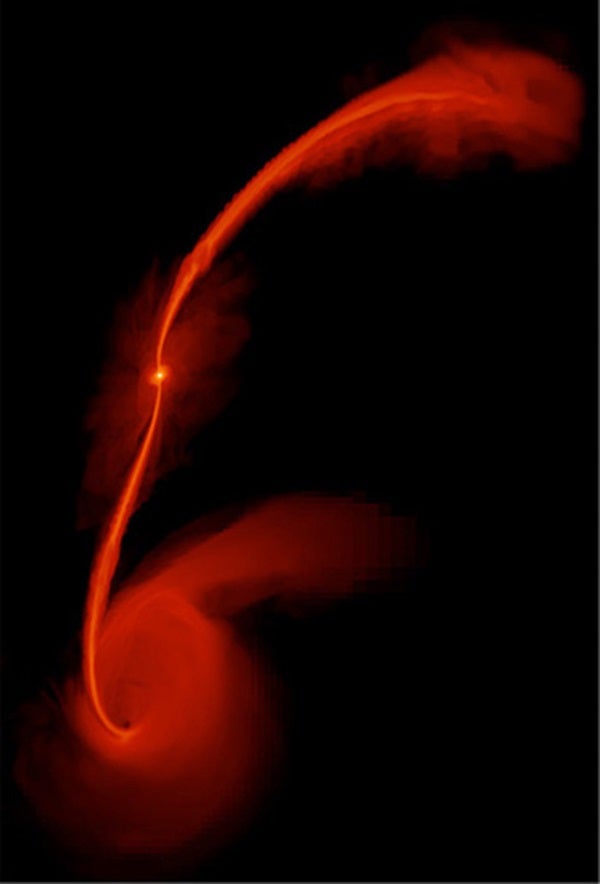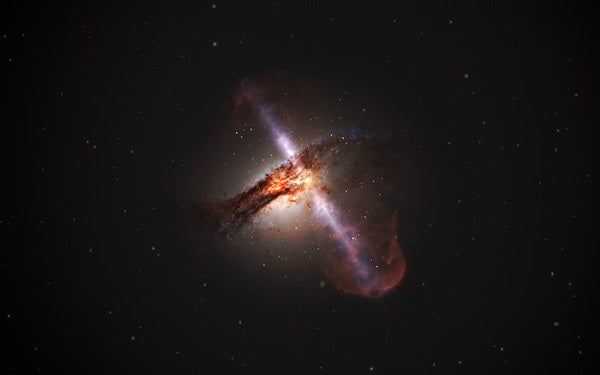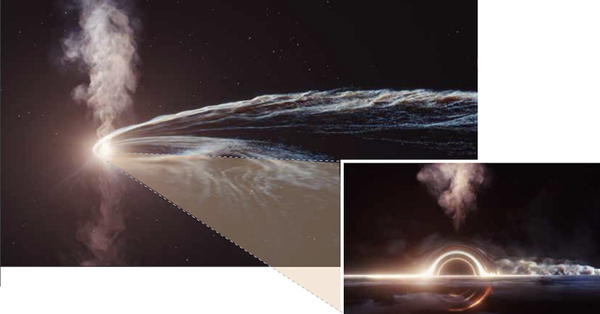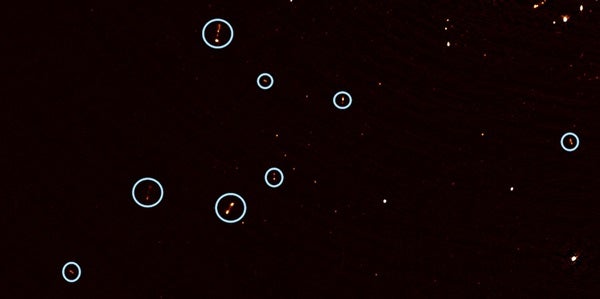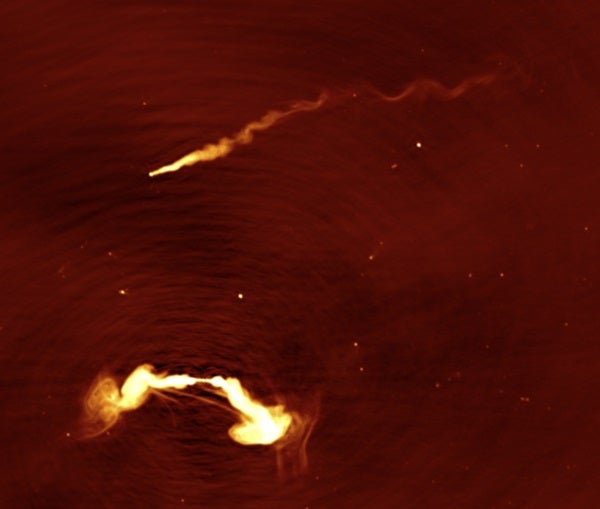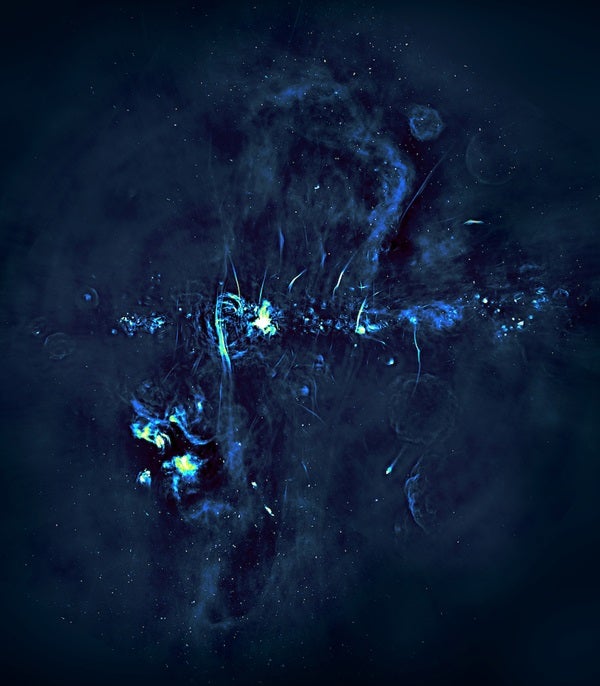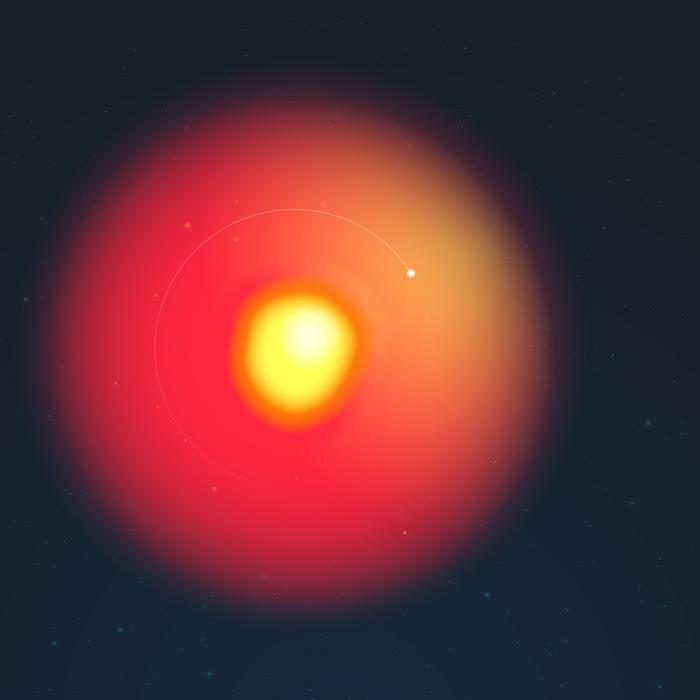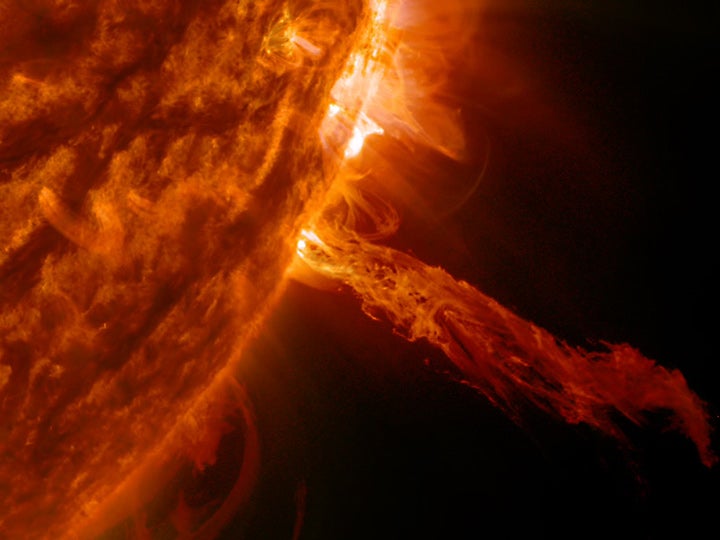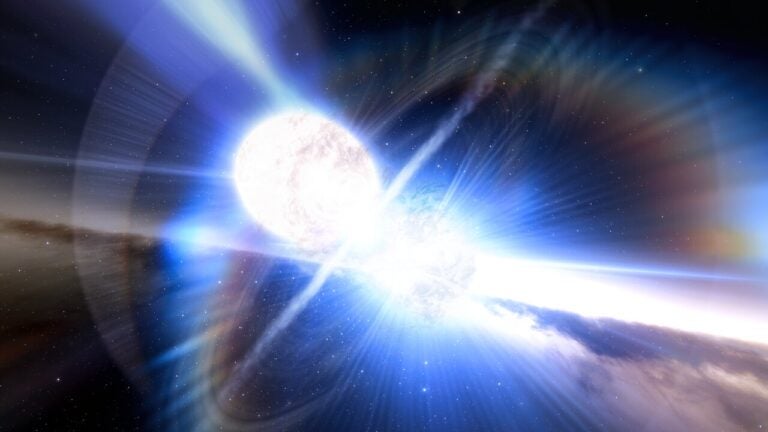I wake up to a chime from my smartphone. Bleary-eyed, I check it — and jolt awake upon seeing an automated email from the MeerKAT radio telescope in South Africa.
The subject line reads: “AT 2018xxx 2hr has been completed.” The message tells me that while I was sleeping, MeerKAT observed a target for two hours and, after some initial image processing, the observation is now ready for me in the archives. All that remains for me, half a world away in Cambridge, Massachusetts, to do is go online and download it.
The lure of potential discovery wakes me up more than a pot of coffee ever could. This could be it! A modern radio astronomer does not have to travel to faraway lands to collect the data herself — arguably less romantic. But the thrill of anticipation and discovery stays the same, no matter where on Earth you are.
I drum my fingers while waiting for my laptop to load the image, excitement mounting as I wonder what I’m about to see. There are a lot of stars and galaxies in this patch of sky, but that’s just window dressing. The real excitement would be overlooked by the untrained eye: a tiny collection of unobtrusive pixels in the middle of the image. It is light from a star’s final gasp as a supermassive black hole at the center of a galaxy gets violent, pulling the star apart and cannibalizing it. A tidal disruption event (TDE), as these occurrences are called, is one of the most energetic and luminous events in the universe. But few are easy to find, and even fewer emit the radio waves crucial to understanding them. Each new discovery is precious.
And in just a few more minutes, I will be the only person on Earth to know whether, for this source, a radio signal exists. I drum my fingers faster.
Torn apart
The story of a TDE begins at the heart of a galaxy, near the edge of a supermassive black hole millions or billions of times the mass of the Sun. Astronomers now think that practically every large galaxy has one such black hole at its center. These gravitational monstrosities play a key role in the formation of their host galaxies and wield huge influence on their surroundings.
Black holes are famously so dense that even light cannot escape their gravity. But despite popular conceptions, they don’t actually suck material in any more than the Sun sucks in the planets that orbit it. For example, if the Sun were to suddenly compress into a black hole, it would shrink to just 4 miles (6 kilometers) across, yet the planets would continue to orbit as they currently do because its mass wouldn’t change.
The gravity of a black hole works the same way. When astronomers look to the center of our own Milky Way Galaxy, we see over a dozen stars orbiting a common point where our galaxy’s supermassive black hole, called Sagittarius A* (Sgr A*), resides. In fact, astronomers have been observing Sgr A* for so long that they have seen the innermost star, S2, complete one full orbit, which takes 16 years. After establishing S2’s orbital parameters, researchers applied Kepler’s third law of planetary motion to calculate the mass of Sgr A*, which clocks in at a whopping 4 million solar masses. While the final calculation was simple, the work to get the data over so many years was not — in fact, it won astronomers Andrea Ghez and Reinhard Genzel the 2020 Nobel Prize in physics.
S2 looks like it’s on a stable orbit for now, but researchers estimate that thousands of stars, including stellar remnants like neutron stars and white dwarfs, also orbit Sgr A*. When two of these objects have a close encounter, their gravity perturbs each other’s orbits and they head out on new, altered trajectories. Most of these orbits remain stable, or perhaps fling the star outward from the center of the galaxy. But on rare occasions, a star’s new orbit sends it inward on a collision course with disaster.
As the doomed star approaches the supermassive black hole, it begins to experience tidal forces: Because gravity is stronger closer to an object, the black hole pulls more strongly on the star’s near side than its far side. Eventually, when the star reaches a certain distance from the black hole — the tidal radius — the difference in force from one side to the other becomes greater than the star’s self-gravity holding it together.
When this happens, “the star gets stretched along its direction of motion,” explains Enrico Ramirez-Ruiz, an astrophysicist at the University of California, Santa Cruz, who specializes in TDE theory. The star deforms from its usual sphere into an oval, and then into a long, thin stream. This process is called spaghettification. As it occurs, the star’s density decreases and fusion at its core stops altogether. Though a star may take millions of years to form and shine for billions more, this final unraveling takes just a few hours.
The hunt for TDEs
What happens next? “Half the star’s material falls in and forms an accretion disk around the star,” explains Ramirez-Ruiz, “and half gets ejected.” The material in the disk falls onto the black hole and feeds it, powering a luminous flare that can be seen at vast distances before slipping past the black hole’s event horizon (where light can no longer escape).
At first glance, these dazzling events can resemble a supernova — a massive star that explodes at the end of its life when its fuel is exhausted. To distinguish TDEs from supernovae, astronomers keep an eye out for two things. First, they look for a bright flare at the center of a galaxy whose supermassive black hole was previously dormant. Then, they break down the light by wavelength and study its spectrum to see what elements it contains. Unlike in a supernova, the elements observed in a TDE flare are similar to those in main sequence stars that are still burning strong. If your flare fits both criteria, you have a potential TDE on your hands!
Astronomers spotted the first TDE candidates in the 1990s. In recent years, finding them has gotten easier thanks to automatic sky surveys that scan the night sky for transient objects — signals that change in the sky over time instead of remaining constant. Still, to date, we have only observed about 100 TDEs.
That’s because TDEs are rare. Astronomers estimate that a galaxy like the Milky Way has a TDE no more than once every 100,000 years. Supernovae, on the other hand, occur in a galaxy our size roughly once a century.
An incredible picture
Arguably the most famous TDE to date occurred in 2011, when NASA’s Neil Gehrels Swift Observatory detected a strange burst of radiation from the center of a galaxy 3.8 billion light-years away. Swift was launched in 2004 to study gamma-ray bursts — immensely energetic bursts of radiation that occur during a supernova or a neutron star merger. But unlike those bursts, which last no more than a few minutes, this radiation just kept going. “It was unlike anything we had seen before,” recalls Joshua Bloom, an astronomer at the University of California, Berkeley, who was a lead investigator on the signal.
Soon, telescopes spanning the entire electromagnetic spectrum were pointed at Swift J1644+57, as the event came to be known. Different physical processes emit different kinds of radiation, and often the key to unraveling an astronomical mystery lies in observing as many wavelengths as possible.
An incredible picture emerged: A TDE had occurred around a previously dormant black hole and, as part of this process, the TDE had somehow launched a jet of material traveling at near light-speed, so fast that the laws of relativity must be considered. This relativistic jet was aimed directly at Earth — and astronomers were staring directly into the beam. “It was one of my only times as an astronomer where I had an ‘ah-ha!’ moment, and all the little pieces started coming together in my head,” recalls Bloom. “We didn’t have all the details yet, but observationally and theoretically it seemed to click.”
In X-ray wavelengths, astronomers noticed a consistent rising and falling pattern in the TDE’s brightness. They realized these were flare-ups from shredded material falling into the black hole, constantly fueling the jet. Another key piece of information came from radio wavelengths. By measuring the signal intensity over multiple frequencies, astronomers could extract a range of information. This included the energy in the jet, as well as the radius of the blast wave that created the radio signals, and even the density of material it was plowing through. Finally, optical observations confirmed the location of the source itself: smack in the center of the host galaxy, where a supermassive black hole lurks.
Then, after about a year and a half of this activity, the X-ray signal suddenly dropped off precipitously, to the point where Swift could no longer detect it. Astronomers realized they’d just witnessed another incredible event — the jet turning off. Normally, relativistic jets from black holes last for thousands of years, at least. The fact that this one lasted for less time than it takes Mars to orbit the Sun was unprecedented, and a boon for astronomers working to unravel their mysteries.
Once the jet turned off, the shock wave from Swift J1644+57 slowly faded in energy. The X-ray emission is now long gone, but the blast still has enough power to send out radio waves that the Very Large Array (VLA) in New Mexico can study for 100 years. I know this because I did the analysis myself.
THE DEATH OF A STAR: 1) Tidal disruption events begin with a star orbiting a supermassive black hole at the heart of a galaxy. If it makes a close encounter with another star, it can be thrown into a death plunge towards the black hole. 2) As the star nears the black hole, tidal forces begin to grow, distorting the star — the process of spaghettification. 3) Eventually, the tidal forces become stronger than the star’s self-gravity, ripping the star apart. Some of the disassembled stellar material forms an accretion disk around the black hole, and some of it is flung into space. 4) As matter swirls around the black hole, magnetic fields focus some of the material into a powerful jet, whose particles travel at close to the speed of light. This creates shock waves inside the jet that produce intense beams of X-rays and radio waves.
I began my Ph.D. in astronomy in 2011, with an aim of specializing in transient radio astronomy. (I wanted to be a radio astronomer ever since I read Contact by Carl Sagan as a teenager, so this was an inevitable choice.)
When I heard about Swift J1644+57, I was impressed by how much information the radio signal contained. When I finished my Ph.D. and the opportunity arose to become a postdoctoral fellow at Harvard with the group that had done the initial Swift J1644+57 analysis, I jumped at it — and got to analyze the latest data on the TDE. Sure, I was years after the main fireworks and it was a ton of work, but I’d nevertheless stop every once in a while to marvel at my luck.
The great mysteries
When people hear I’m an astronomer, they’ll often ask me what the most interesting unanswered question in the universe is. The honest answer is that it’s frequently the thing I am working on at that moment — the more you research a subject, the more you come to appreciate its intricacies.
So here is the mystery about TDEs in general, and Swift J1644+57 in particular, that keeps me wondering: While it is the best-studied TDE on record, Swift J1644+57 was not predicted and is not at all like other TDEs we’ve seen. It was a thousand times more luminous in radio waves than other TDEs and over 10,000 times more energetic, thanks to its relativistic jet. On the other hand, in an “ordinary” TDE, material tends to flow out in all directions with energy levels similar to what we see in a supernova explosion — still awesome and impressive, of course, but a bit like comparing a conventional explosion to a nuclear bomb.
Coincidentally, Swift did spot two more jetted TDEs in 2011, but at much greater distances, so they couldn’t be studied in detail. Otherwise, all the TDEs we’ve seen have fallen into the ordinary category. At this rate, it looks like just 1 percent of all TDEs launch a relativistic jet, and we still don’t understand what makes those TDEs so special. Perhaps the star unbinds particularly fast, or the magnetic fields around the black hole are extraordinarily high — but without more events, it’s hard to know for sure.
Another mystery about TDEs that keeps me wondering is that while we know a lot of the material falls into the black hole, lots of it doesn’t. “We know supermassive black holes are messy eaters,” my collaborator Kate Alexander, an astronomer at Northwestern University, likes to joke. How the leftover material interacts with the surrounding environment is still an open question.
If we are going to understand TDEs and how these black holes shape their environments, we need to follow up on as many new events — and in as many wavelengths — as possible. So far, less than half of known TDEs were detected with radio signals.
Alexander hopes to change that, and oversees a large VLA observing program (in which I also participate) to follow up on all new TDEs discovered in our local universe. The program has the right to “trigger” the VLA whenever a new TDE is discovered by another facility at another wavelength — that is, interrupt the schedule for time-pressing observations of our own to gather more data on nearby TDEs.
Fresh eyes
However, the VLA can’t do this work alone. From its location in New Mexico, it cannot see about a third of the southern sky. In fact, until the past few years, all but the brightest TDEs were unobservable in the southern skies because there was no facility as sensitive as the VLA with the right view.
Fortunately, this situation is changing rapidly, thanks to new telescopes like MeerKAT. Consisting of 64 antennas in South Africa’s Karoo region, it’s just as sensitive as the VLA. Eventually, it will become part of the Square Kilometer Array, which will be the most powerful radio telescope on Earth once completed in 2030, and comprise dishes scattered across South Africa and Australia.
MeerKAT saw first light in 2016 and, when the first call went out for non-South Africans to propose observations with MeerKAT, I jumped at the chance. My targets? A half-dozen TDEs, most of which had never been observed at radio wavelengths.
And that’s how I found myself waking up one morning to a cellphone chime triggered by a radio telescope half a world away.
I’ve been lucky enough in my career to use a dozen different radio telescopes, but it was clear from the beginning that MeerKAT is different. I’m used to sources appearing as featureless blobs, but the detail and wide field of MeerKAT images make them unquestionably the prettiest I’ve seen — a large swath of sky with dozens of tiny galaxies floating in space. It is not unlike the Hubble Deep Field, but instead of the visible starlight Hubble sees, the galaxies in MeerKAT’s radio images are powered by the supermassive black holes dwelling in their centers interacting with stray gas and dust. These encounters are steady, low-energy events that fuel most of the black holes in the universe.
Still, they’re not what I’m after.
Finally, the MeerKAT image loads on my laptop. I pause to take in the whole thing — it feels like floating in space, if just for a moment — before zooming in to the center. And … there! A smudge of light at the center — the flare from a dying star whose remnants are being swallowed by a black hole, suspended alone in the middle of the cosmic ocean.
I smile and start planning the next steps of my analysis. The end of this star’s journey means the beginning of my attempt to unravel its story, and there’s a lot of work to do.

